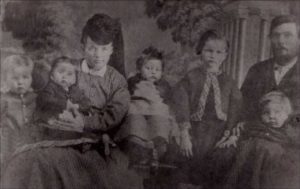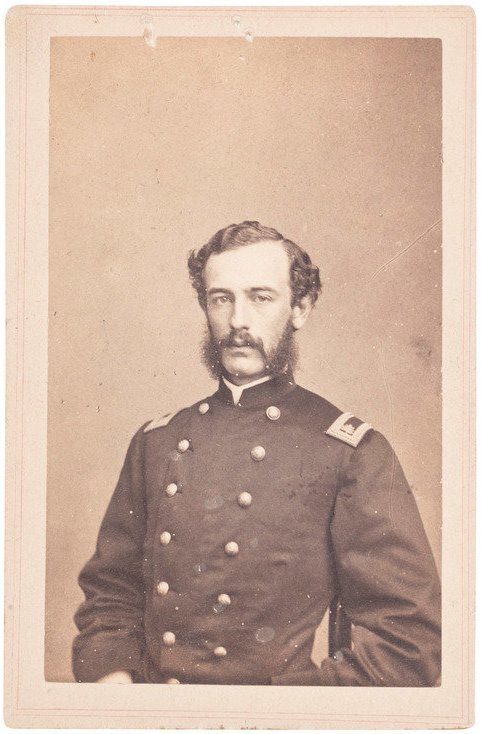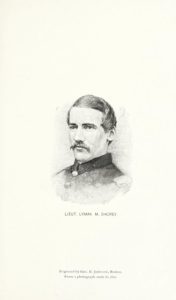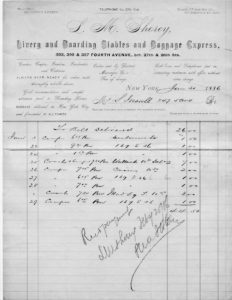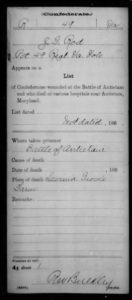G.W. Bynum, 2nd Mississippi (c. 1861)
10 July 2022
Author and blogger Mike Brasher kindly provided this excellent photo of Private George Washington Bynum, who was with the 2nd Mississippi Infantry at Boonsboro and Sharpsburg, MD in 1862. We was later an officer of Mississippi Cavalry and survived the war to farm in Alcorn, MS and serve as Mayor of Corinth from 1896-98. The original of this photograph is owned by Mark W. Blackburn.
Lt William Horton (1862)
6 July 2022
5 days after his 31st birthday – on 17 September 1862 – First Lieutenant William Horton of Company I, 16th Connecticut Infantry, from Stafford, CT, was killed at Antietam. This fine photograph of him is courtesy of descendant Laurie Mack, and was forwarded to me by John Banks.
John N Ferguson and family (c. 1870)
13 June 2022
Here are John Nimrod Ferguson, his wife Martha Rebecca Weldon, and the first 5 of their 15 (!) children, in about 1870.
Ferguson had enlisted in July 1861 and was elected 2nd Lieutenant of Company C of the 13th Georgia Infantry in September 1862. He was promoted to First Lieutenant on the field and wounded at Sharpsburg on the 17th and survived another wound, at Monocacy in 1864, to return home to Griffin, GA.
In 1870 he took his family to Union Parish, LA and farmed there. In the 1880s he was elected Constable and was murdered while on Parish business in December 1887.
____________
The photograph above was contributed to Martha Rebecca Weldon Ferguson’s memorial on Find-a-grave by Kenneth Pace.
Emma Lent and the rumseller (1886)
13 June 2022
Private James W Lent was about 20 years old when he was wounded at Antietam on 17 September 1862. He continued in service with the 7th Maine and later the First Maine Veteran Infantry to muster-out in June 1865.
I’ve found very little more about him, but this news clip from the Portland Daily Press of 30 March 1886 [online from the Digital Maine Repository] hints at his post-war story:
________
My transcription
Emma J Lent of Manchester [ME], has commenced an action against a rumseller of that town to recover $2000 for selling liquor to her husband.
Pvt Thomas Pearson, Hawkins’ Zouaves (c. 1861)
12 June 2022
This photograph of Thomas Pearson, mortally wounded at Antietam, comes from the amazing collection of Civil War Biographies compiled by volunteers on behalf of the Green-Wood Cemetery in Brooklyn, NY.
Maj James L Van Buren (1862)
8 June 2022
This fine carte-de-visite (CDV) has just been offered for sale by Hindman Auctions. It’s of Major James Lyman Van Buren, and accompanies his saber and belt, insignia, and other photographs, all from the Collection of Bruce B. Hermann.
The Major was on General Burnside’s staff at Antietam and had distinguished staff service through the war, ending at the brevet rank of Brigadier General of Volunteers. He died soon after mustering out in 1866 of a bacterial infection of his liver, just 28 years old. He was a cousin of President Martin Van Buren.
Lt Lyman M Shorey (1862)
7 June 2022
First Lieutenant Lyman Munson Shorey‘s military career with the 7th Maine Infantry ended with a serious wound to his foot in an ill-fated charge on the Piper Farm at Antietam on 17 September 1862.
Afterward he returned to school, graduating from Harvard with a law degree in 1864 and studying in the Divinity School there for a year to 1867. He went into the baggage express (delivery) business in New York City with his sister Elvira’s husband Hiram Studley and he took over the company after Hiram retired in 1872. Here’s his impressive letterhead on a customer’s receipt from January 1886.
His picture here from an engraving after a photograph in William C Hatch’s A History of the Town of Industry (1893), online from the Internet Archive. The receipt is among the Thomas A Edison Papers, Digital Edition, at Rutgers University.
One of the most tragic scenes of the Battle of Antietam was the ill-conceived charge of Major Thomas Hyde‘s 7th Maine Infantry on the afternoon of 17 September 1862 at the order of their brigade commander Colonel W.H. Irwin.
Sergeant John C McKenney of Company B recounted his recollection of that day in Old Eliot: a Quarterly Magazine of the History and Biography of the Upper Parish of Kittery, now Eliot in 1906 [online from the Internet Archive]:
Here’s my partial transcription:
I was First Sergt. of B Company, and went into the fight when I could honorably have kept out, as I was on the sick list at the time, and had been for nearly two weeks. The Regiment went into the battle with less than two hundred men.
In the forenoon we were supporting a battery. In the afternoon we were ordered to advance and drive back a large skirmish line of Rebels in our front. We advanced and drove them back over a short hill; and when we reached the top of the hill, we found a rebel brigade waiting for us. They gave us a volley, which we returned the best we could. In a few minutes we discovered that the Rebels were on our flank and rear; they opened fire on us from that direction.
Maj. Hyde immediately gave the order: “By the left flank, double quick, march!” A rail fence was in our path, and a gap had to be made by the head of the column to get through. Maj Hyde could not go where the men were filing through; and 1st Sergeants Hill, Benson and McKenney, stopped and tore down a place for the Major to get his horse through. By this time all had passed on, and left the three Sergeants in the rear of the command. All were running to get out of the trap. I being weak and exhausted, was soon left behind; I was compelled to surrender, and was reported missing. Sergeants Hill and Benson escaped, and were promoted for special bravery.
[pg. 173] For five days we lived mostly on green corn taken from the fields through the Shenandoah Valley. We reached Staunton, and were put into cattle cars, sent to Richmond, and confined in Libbey Prison thirty days.
________________
I haven’t found a photograph for McKenney, but here are Sergeants (by then Lieutenant and Captain, respectively) Benson and Hill, thanks to the Maine State Archives.
7th Maine veterans meet in Saginaw, MI (1886)
5 June 2022
From the Grand Traverse Herald of 22 April 1886 (online from the Libraries of Central Michigan University) comes this tidbit about Antietam veteran and late Sergeant of the 7th Maine Infantry Eli McLaughlin.
Two mystery deaths after Sharpsburg
5 June 2022
Jim Buchanan of Walking the West Woods kindly forwarded me cards for two Virginia soldiers said to have died of wounds in US Army field hospitals after the battle of Antietam on 17 September 1862. These are from the National Archives Record Group 109: War Department Collection of Confederate Records, 1825 – 1927.
Privates J.G. Rod, 49th Virginia Infantry and C.W. Keese, 23rd Virginia Infantry.
Unfortunately I cannot identify these men using available military, genealogical, census, or burial records. They don’t correlate with anyone in those regiments with even similar names.
I welcome any assistance you can offer.
For the moment, then, these names do not appear in the AotW database – I don’t know enough about them to know if I already have them listed under other names, or if I’m missing them altogether, which would be regrettable. The nature of the beast, I guess, given the often incomplete or erroneous records of the period.


